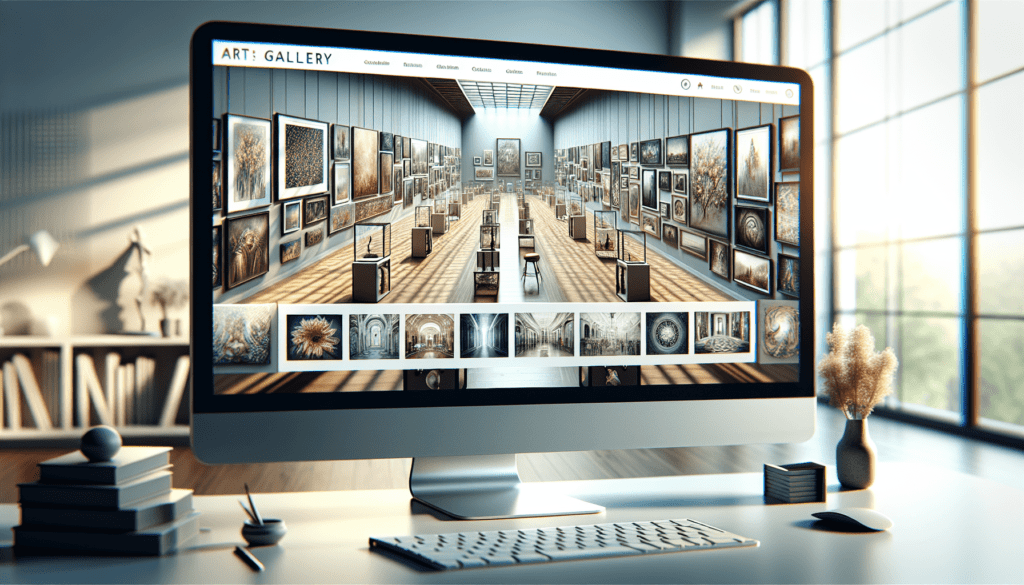Are you an artist looking to take your work to the next level? In today’s digital age, having a strong presence online is essential for success. That’s where website creation comes in. In this article, we will explore the world of website creation specifically tailored to artists. We’ll discuss the importance of showcasing your work online and provide expert tips on how to create a captivating website that truly represents your artistic style. So, if you’re ready to elevate your art and make a lasting impression on your audience, let’s dive into the world of website creation for artists.

Choose the Right Platform
When it comes to creating a website to showcase your artwork, it’s important to choose the right platform that aligns with your needs and goals. There are numerous website builders available, each offering different features and pricing options. Take the time to research and compare these platforms to find the one that suits you best. One helpful tip is to take advantage of free trials whenever possible. This way, you can test out the platform and see if it meets your requirements. Look for a platform that offers a wide variety of templates and customization options, so you can create a unique and visually appealing website that reflects your artistic style.
Define Your Brand and Style
Before diving into creating your website, it’s essential to define your brand and style. Start by identifying your target audience. Who do you want to attract with your artwork? Understanding your audience will help you tailor your website accordingly. Once you know your target audience, create a cohesive brand identity. Determine the message and emotions you want your artwork to convey and incorporate that into your website design, color scheme, and overall aesthetic. Choose a color scheme that complements your artwork and select fonts that reflect your artistic style. Additionally, consider designing a logo or using your signature as a branding element to further establish your artistic identity.
Organize Your Portfolio
An organized portfolio is crucial for showcasing your artwork effectively. Categorize your artwork into different sections based on medium, style, or any other relevant criteria. This will allow visitors to navigate your website easily and find the specific pieces they are interested in. Arrange your artwork in a visually appealing way, using a grid or gallery format, while ensuring that each piece stands out. Remember to include essential information for each artwork, such as the title, medium, size, and price. If you wish to provide more depth, consider adding artist statements or descriptions that provide insight into the inspiration and meaning behind your pieces.
Optimize Your Website for Search Engines
To ensure that your website gets the visibility it deserves, it’s important to optimize it for search engines. Start by researching relevant keywords related to your artwork and incorporate them into your website content, including titles, headings, and descriptions. Pay attention to meta tags and descriptions, as these serve as brief summaries for search engine results. Optimize your image file names and alt text to help search engines understand the content of your images. One effective way to improve your website’s rankings is to create a blog or news section where you can regularly update your website with fresh content, keeping it relevant and engaging.

Create Engaging and High-Quality Content
To captivate your audience and leave a lasting impression, it’s important to create engaging and high-quality content for your website. Use high-resolution images of your artwork to ensure that visitors can appreciate the details and textures of your pieces. Consider adding videos or virtual tours to provide a more immersive experience. When writing artist biographies and about sections, make them compelling and authentic, allowing visitors to connect with your story. Share the story behind your artwork, the inspiration behind each piece, and the creative process involved. Including testimonials from satisfied customers or gallery owners can also help build trust and credibility.
Integrate Social Media
Social media is a powerful tool for artists to showcase their work and connect with a wider audience. Integrate social media buttons on your website to encourage visitors to follow you on platforms like Facebook, Instagram, or Twitter. Including share buttons also makes it easy for visitors to share your content with their friends and followers, increasing your reach. Another great way to leverage social media is by embedding your Instagram or Pinterest feed directly on your website. This allows visitors to see your latest posts and discover more of your artwork. Additionally, make sure to regularly share updates and new artwork on your social media platforms, interacting with other artists and art enthusiasts in the process.
Enable Online Sales and Payments
If you’re looking to sell your artwork directly through your website, it’s essential to enable online sales and payments. Choose a secure and user-friendly e-commerce platform that integrates seamlessly into your website. Set up a shopping cart and create individual product pages for each artwork you wish to sell. Offering multiple payment options, such as credit cards and PayPal, gives your customers flexibility and convenience when making purchases. Be transparent about shipping costs and provide clear information on delivery times and processes. Ensuring a smooth and secure checkout process is vital to maintaining customer trust and satisfaction.
Optimize for Mobile Devices
With the majority of internet browsing happening on mobile devices, it’s crucial that your website is optimized for mobile users. Use a responsive website design that adapts to different screen sizes, ensuring that your artwork looks its best on any device. Test your website on various screen sizes to make sure it displays properly and that all functionality is maintained. Fast loading times are essential, as mobile users expect quick access to information. Optimize your images for mobile devices to reduce load times without compromising image quality. Finally, make navigation easy and intuitive on mobile, with clear menu icons and an organized layout.
Include Contact Information
Don’t forget to include contact information on your website to make it easy for potential buyers or interested parties to get in touch with you. Create a dedicated contact page that provides your email address and phone number. Adding a contact form allows visitors to send inquiries or messages directly through your website. If applicable, consider providing a studio address to showcase your physical presence and create a sense of authenticity. It’s essential to promptly respond to any customer inquiries to show that you value their interest and engagement.
Regularly Update and Maintain Your Website
To keep your website fresh and engaging, it’s important to regularly update and maintain it. Refresh your portfolio with new artwork as you create and release new pieces. Update your artist biography and about sections to reflect any changes or milestones in your artistic journey. Be proactive in fixing broken links and errors to ensure a seamless user experience. Regularly test website functionality, including forms, buttons, and e-commerce processes, to identify and address any issues. Finally, backup your website regularly and protect it with appropriate security measures to ensure the safety of your valuable content.





